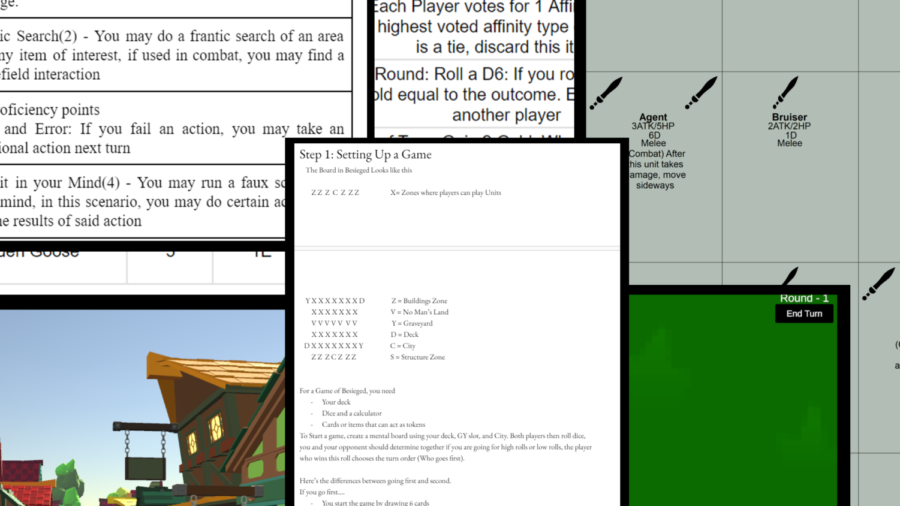The Three Year Process: The Journey of a Novice Game Designer
A look back at my three years of game development and a review of each iteration.
Here are various iterations of my game development.
For the past three years, I have embarked on the journey of game development. I went through dozens of ideas, looped through the hoops of initial design and beta testing over and over again, tested my mettle and morphed to criticism, and got a game published. Through this process, I’ve learned alot about game making; so let’s look at my journey.
Pathfinding
I began my adventure in game making by modifying existing games. I loved adding homebrewed rules to board games and always tried to create new things to play with. One of the games I loved altering was the tabletop roleplaying game Dungeons and Dragons, as its ruleset is very math oriented and actively supported custom content creation. One of the roles in a game of D&D is the dungeon master, a player that creates the situations that the other players interact with. Initially, I used a lot of the official content and books, but very quickly, I started to design my own content.
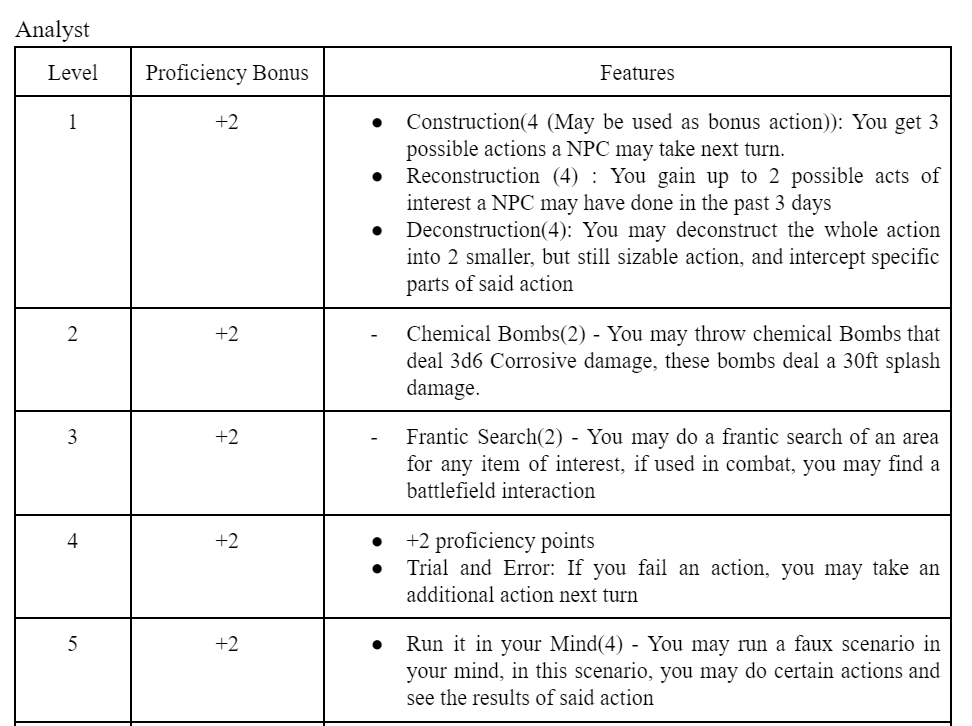
I started by designing characters that the other players interacted with; writing unique dialogue for them, designing shops and small quests, giving them distinct visuals and so forth, before moving onto designing enemies and items, often reusing existing abilities. But, eventually I started designing new spells and abilities for these enemies and items. I would test these out with my normal play group, getting their feedback and going back to make changes for balance and so forth.
I would continue to make things for my group until we grew bored of D&D, and once we did, we started to play around with all the other options we had. It was through this I stumbled onto Pathfinder, another table-top RPG System that gave me a lot of freedom to explore. It was here that I started learning about actual game design.
When I was making things for D&D, I stuck closely to the rules and confines of the game, doing everything by the core game rules, and refusing to alter or adapt new rules to make ideas fit. But with Pathfinder’s more abstract design, I was forced to find new ways to use the rules and drastically alter the feel of the game.
Looking back, Pathfinder and D&D taught me a very important lesson: restrictions breed creativity. When the possibilities were left open, I was overwhelmed by what I could do, and instead of exploring those possibilities, I decided to stick to simple methods, never going beyond the basics.
Abominable Ego
When I got into card games like Magic: The Gathering and Hearthstone, I became enamored with the card design process. I would read through the dozens of posts by developers on card design and design philosophies. Additionally, I would participate in the custom content making community, creating my own cards and playing them with people online.
But I soon grew bored of remixing mechanics of existing games and became annoyed at many of the decisions made by the companies behind the games. That distaste made me want to design a game better than what I’d been playing.
As the adage goes, good artists copy; great artists steal. With my first design, I took that to heart. My first game was an abomination that took the legs of Magic: The Gathering, the torso of Hearthstone, and the heart of Yugioh. Looking back now, I can see that it was a mess that had very little unique to offer. But back then, I felt extremely proud of this stitched together creation.
I would shelter my game from a lot of deserved criticism by constantly calling it a prototype, then refuse to change the parts of the game people had problems with. Additionally, I never wrote a rulebook for this game, further sheltering it from criticisms of poor rule writing and so forth. I also refused to test it outside of a limited environment until I had a lot of content to show off.
Looking back, all I could say is that I was extremely full of it. I was over-confident in my game design abilities, and I was way too focused on what the game could be. I became way too enamored by the possibilities of secondary or tertiary modes of play that could exist outside of the gameplay itself.
I abandoned this game shortly after I started it. It would go no further than a lot of miscellaneous ideas and a few tests with friends and family. But I would revisit this game often, and see how I had improved and grew from then.
Teachers and Testing.
As lockdowns began towards the middle of 2020 due to the Coronavirus pandemic, I found myself with a lot of free time. And instead of melting into my couch and watching television shows or playing video games, I decided to join game testing groups and provide feedback as well as learn from the designers on their perspective and game design process.
During this testing spree, I got to try out a lot of different games of various genres, from in-dev versions of board games to turn-based strategy games to various battle arenas to role playing games and even several trading card games. Testing out games of different genres gave me a much more expansive understanding of game design.
Two of the more interesting games I encountered during this time were Sorcery: Contested Realms, a trading card – board game, and Fangs, a multiplayer battle arena. I became extremely engaged in the communities of these games, participating in their often weekly events, giving suggestions and feedback wherever I could. They were both games made by relatively prolific designers, and I got a great deal of knowledge by looking at how they interacted with their community and handled feedback and criticism.
It was through this process, I met Alex, who was a consultant for one of the games and a former game designer himself, as well as Greg, who was studying game design and was developing his own game at the time. They shared similar viewpoints with me on game design and on the problems with the games we were testing and were brutally honest and gave extremely honest and critical feedback to the designers. This was exactly what I needed, so I asked them for help on my game.
They both agreed, and eventually, Alex would become a mentor of sorts to me, as I found myself talking to him whenever I needed guidance or a knock to the head, and Greg would become a tester for my games, giving me specific feedback on my designs and ideas.
Looking back at this, it was absolutely incredibly lucky of me that I met Alex and Greg at this time. I was very lost with my first foray into game design and lacked a strong hand to guide me in the process. This allowed me to explore different designs more, get opinions and feedback that I could trust, and have a sounding board to bounce ideas off of.
An Archive of Documents
After talking to Alex and Greg for a while, I grew as both a person and as a game designer. I became a lot more patient with my designs, and I became a lot more accepting of criticism. Instead of pushing back at every opportunity, I accepted the suggestions, changed my perspective, and adjusted the game accordingly..
This was the starting point for my first real project, Archives, which was another card game. And in fear of messing it up, I would, at every point of difficulty, ask for help from Alex and Greg. This is also when I started to make design documents, proper spreadsheets and documentation on the rules of the game, the changes I made along the way, and the various iterations of the game.
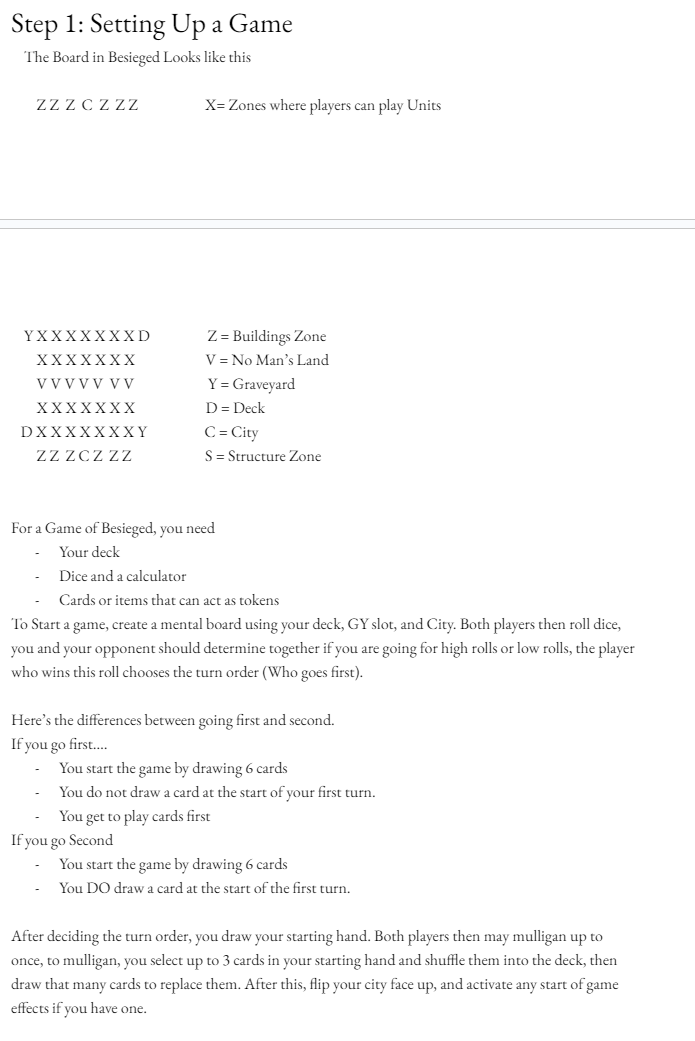
Organization was super important for this project, and it was my first taste of what could be called “big time” game development, and I felt extremely prepared with all of my previous studies of other games. I was able to get the first iteration of the game done a few weeks after I started the project, focusing on several core tenets and one key experience I wanted the players to feel.
When I finished my first iteration of the game, I tested it with people around me. I would give it to close friends to other game designers to just any random people at my local card shop who were willing to give it a chance. I then took that feedback and compiled it into a document, looking at common complaints and trying my best to address them. I then asked them about how they felt about the game in comparison to the games they usually play, and used this to gauge who my target audience were.
Feedback included a variety of complaints ranging from problems with the balance and lack of “coolness” of the cards to the lack of visuals to help differentiate cards. I also received some compliments on the core design of the game, and it was made abundantly clear that I succeeded on my intended experience.
For the second round of testing, I created a survey filled with common complaints from the previous test, then had my testers check off any complaints that they had that were similar to those common complaints. I repeated this for several rounds and at the end of the seventh or ninth round of testing, I had fixed a majority of the problems that people had with the game, and was in a perfect spot to advance the design to a finalized stage.
But that was the end of this test. I had little faith in myself and my ability to turn this prototype into anything more than a prototype. I didn’t know art, or music, or any of the other elements that made a game a complete game. So I abandoned it out of fear and never advanced any further with the design.
Eclectic Mayhem
After Archives, I started working on several other projects to develop specific skills. This included Capture Coldtooth, Fable Forces, and Marketplace Mayhem.
Capture Coldtooth was a turn based board game that taught me how important it was to keep people in the action. The game’s goal was to have two players control 4 characters on a grid and fight for a mine at the center of the map. Initially, players got extremely bored. I asked for help from Alex on this, and he told me to focus on the action rather than the strategy. I originally gave pushback on that advice, until I realized that people were getting bored because of how long the set up was before they actually got into playing the game.
Fable Forces was the next excursion into game design, as I started to learn about how to make game content feel unique. Fable Forces was about the player casting spells in quick succession and chaining them to make combos, similar to a fighting game. They would respond to one another, and had actions limited by their fighting styles. Immediately however, I ran into a problem with trying to make different styles feel distinct. So I again turned to Alex for help, he told me to “limit what the players can do in their style and add a cost to mix style” and it worked. Players would create a unique blend of styles and choosing a style felt much more like a representation of the player rather than just something that exists.
Marketplace Mayhem gave me a lesson in creating casual experiences, games that were less about the actual game, and instead the experience people have with their friends. The game was about players managing shops to sell to a deck of customers, and each round involved players negotiating and fighting each other for items. During tests for the game, I saw players yell at each other, laughing at certain mishaps, teaming up against each other, and even making sneaky deals without other players knowing. I was extremely happy with this and thought I had succeeded with a design, until players stopped touching the game entirely, as they didn’t see a reason to play it over any other game. Once again, I turned to Alex for help, he told me to “make the game play more focused on competition,” and again it worked. Players would now play the game just to beat each other.
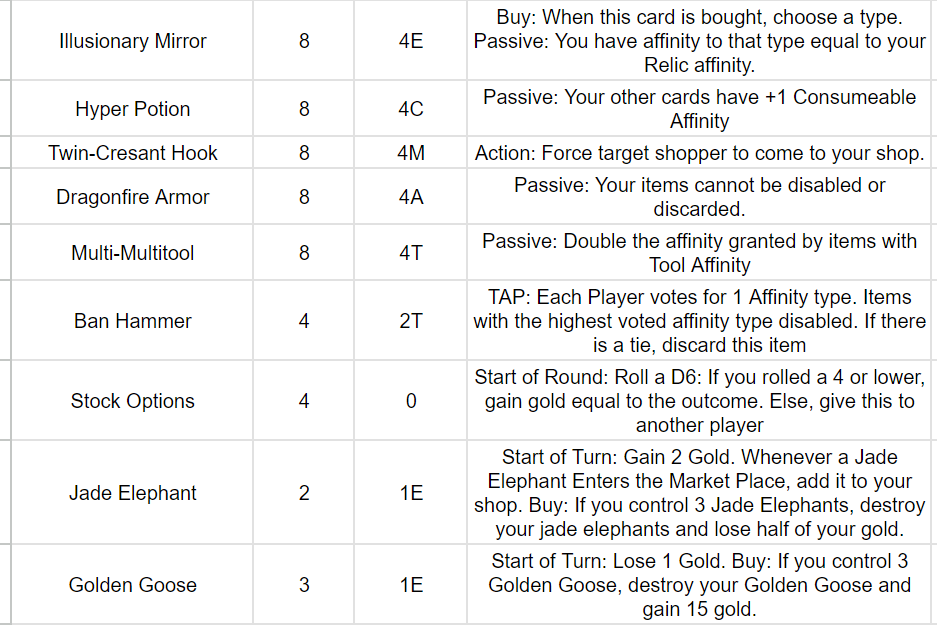
After these designs, I tried to start another big project. I tried my best to make any of these games truly work as a standalone game, but none of them felt like they were solid foundations to stand on. I became lost once more, and unsure of what do, I went to talk to Alex, and he told me that I was in “design hell” and that “though you learned a lot, you still didn’t know a darn thing, you’re never confident in yourself, and you’re always asking other people. I can’t design your game for you, you need to do it yourself.”
When he finished telling me off, he gave me a question to ask myself: Why did I want to make games?
As Towers Fall
I mulled over that question for a few days, revisiting my past games and trying my damndest to find the spark that caused me to want to make games in the first place. I looked at every possible source for my inspiration for game making, from my first game to my latest project. Yet I found nothing.
So I started on one last project, telling myself that if I could not find that spark, I would quit.
I started the design for Towerfall as a culmination of everything I had learned in the past three years. I used the initial creativity I had from custom content making for Dungeons & Dragons and Pathfinder, the ego I had with the stitched abomination, the clarity and organization from Archives, and the new skills gained from Capture Coldtooth, Fable Forces, and Marketplace Mayhem.
When I finished the first iteration, I laughed. The game was a stitched together abomination of every game I had made. It had a board like Capture Coldtooth, except now smaller, heroes and spell casting like Fable Forces, and strange competitive elements like Marketplace Mayhem. It was a mess to say the least.
I had wanted to toss out this iteration and crawl back to Alex and ask for help again, but I refrained, remembering what he said about him designing for me, and went forward with testing the prototype.
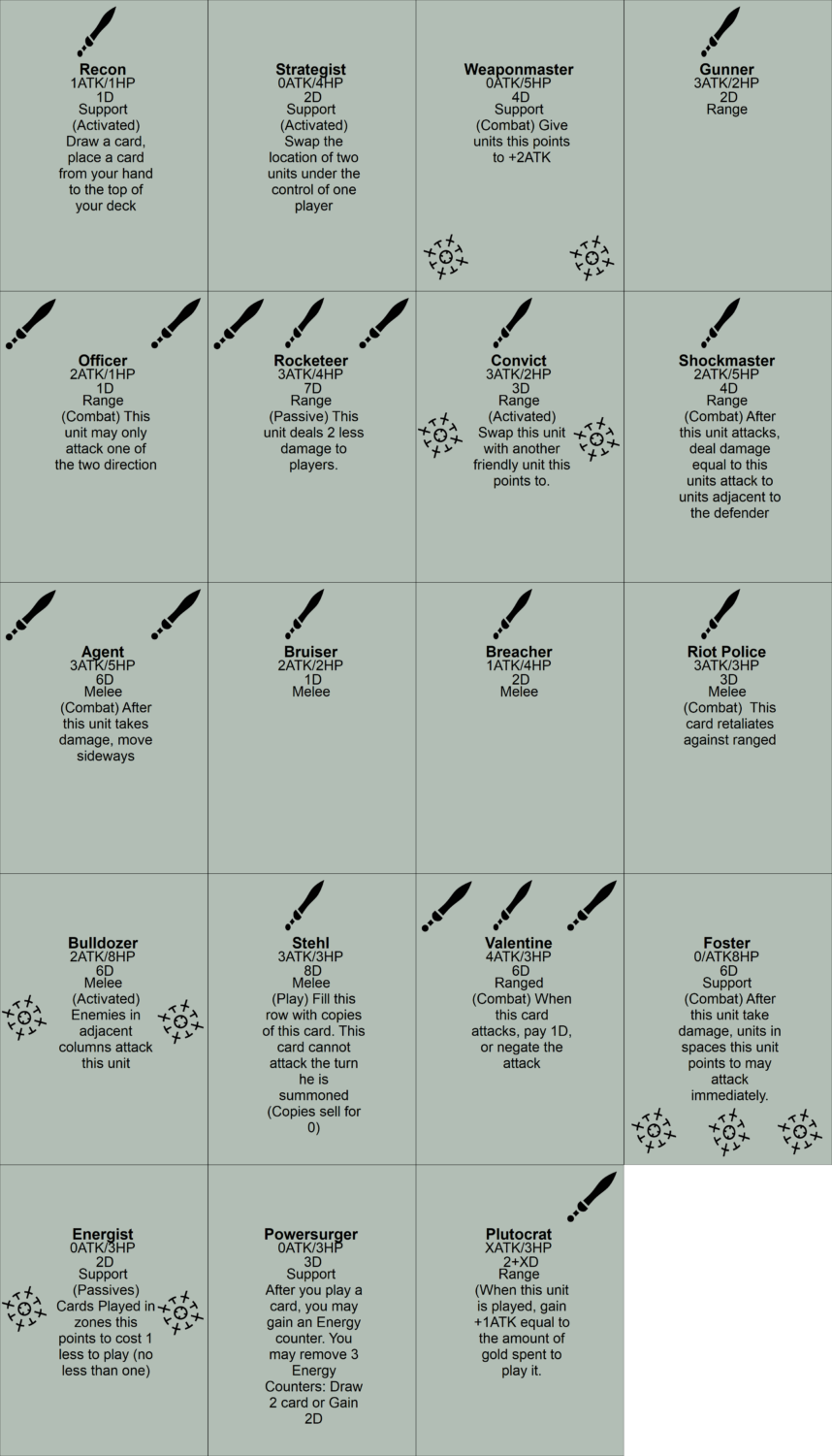
To my surprise, people actually enjoyed playing this prototype. They found the gameplay to be refreshing and new compared to what they usually played, and were happy to get their friends to test it out with me as well. I then went back to Alex and Greg, having them test my game once again and give me their feedbacks. And something they said made me extremely happy with this prototype: “Lets play another round.”
With previous prototypes, I had to ask them to playtest with me, but with this one, they were willing to play it unprompted. I asked them one last time for any information and help before I would stop bothering them and this was what they had to say to me.
“Congrats, you made a game.”
For the past three years, I have embarked on the journey of game development. I went through dozens of ideas, looped through the hoops of initial design and beta testing over and over again, tested my mettle and morphed to criticism, and got a game published. Through this process, I’ve learned alot about game making; so let’s look at my journey.
Tiankuo Zhang is an Editor-In-Chief for 'The Science Survey.' He sees journalism as something that has withstood the test of time and finds the transcriptions...

